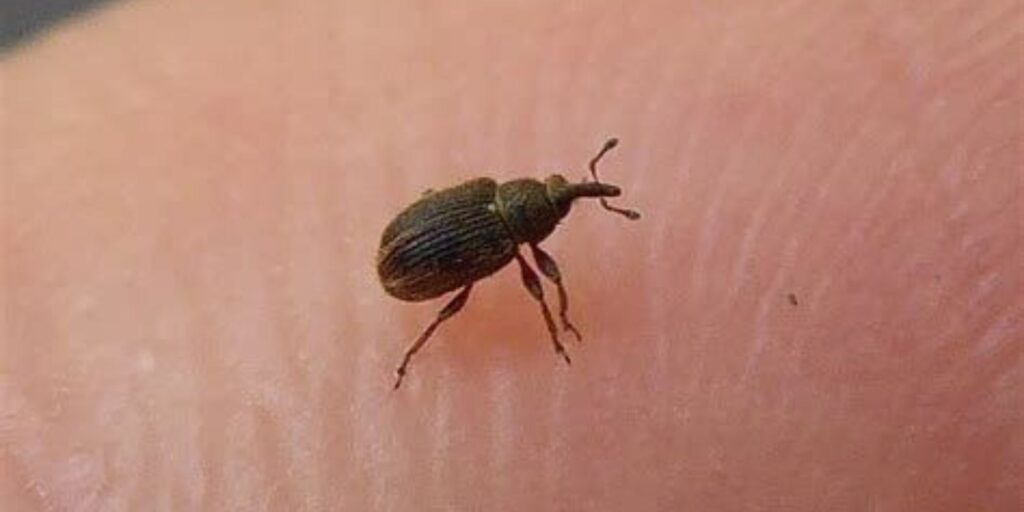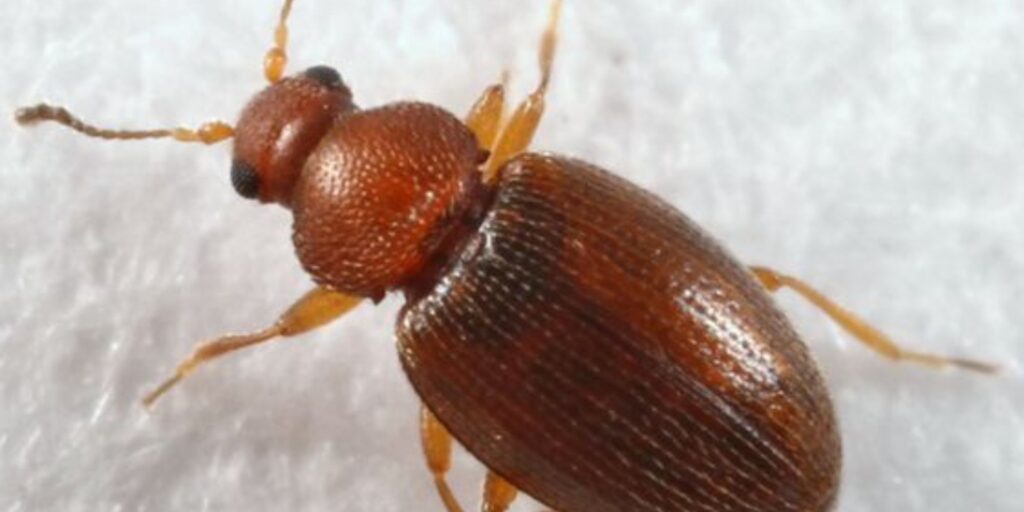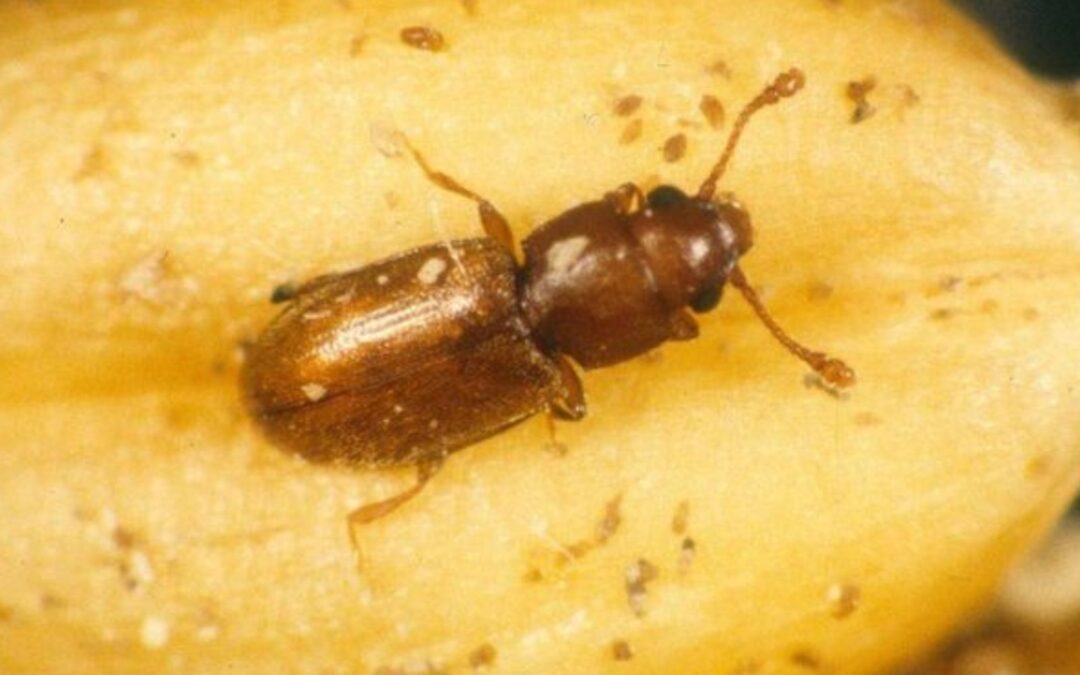Tiny brown beetle are a common sight in many households and natural environments. Despite their size, these unassuming insects can significantly impact you—whether they’re harmlessly making their way through the garden or causing trouble in your pantry. Understanding what these beetles are, their behaviors, and how to manage or prevent their presence is key to coexisting with—or controlling—them.
Whether you’re curious about these tiny creatures or trying to get rid of them, this guide will help you learn all there is to know about tiny brown beetles and their role in our surroundings.
What are Tiny Brown Beetle?
Tiny brown beetles refer to a variety of small beetle species that are generally brown or dark in color. These beetles can be found in various environments, both indoors and outdoors. While they may appear similar at first glance, each type has distinct characteristics, behaviors, and habits that make them unique. Some of the most common types of tiny brown beetles include cigarette beetles, drugstore beetles, carpet beetles, and flour beetles. Understanding the specific beetle you are dealing with can help you manage and prevent infestations more effectively.
Tiny Brown Beetle: Key Characteristics

- Size: Typically, these beetles range from 2 to 5 millimeters long, making them incredibly small and easy to miss.
- Color: Most have a brown to reddish-brown exoskeleton, which gives them their name.
- Shape: Many tiny brown beetles have an oval or elongated body, often appearing shiny or smooth.
- Wings: Most species can fly, using their wings to travel from one spot to another in search of Food or shelter.
While their appearance may not always be alarming, their presence should be noted, as some species can cause damage to homes, stored Food, and fabrics.
Common Places Where Tiny Brown Beetle Are Found
Tiny brown beetles are incredibly resourceful, which allows them to thrive in various environments. Here are some of the places where they are most commonly found:
Indoors
- Kitchen – Certain species, like flour and cigarette beetles, are notorious for invading food storage spaces such as pantries. They infest grains, cereals, flour, and other dry goods.
- Carpets and upholstery—Varieties such as carpet beetles target fabrics, especially those made of natural materials like wool.
- Closets – Beetles can also nest in clothing, particularly when fabric contains sweat or food stains.
Outdoors
- Gardens – Some tiny brown beetles feed on plant material and can often be spotted on foliage or flowers.
- Dry woody areas – Others are attracted to dry wood and may dwell near fallen branches or timber piles.
Understanding these locations is important in identifying how beetles may have entered your space.
Are Tiny Brown Beetle Pests?
Classifying these beetles as “pests” largely depends on the type of beetle and the setting in which you find them.
The Harm They Can Cause
- To food supplies: Beetles, such as drugstore and flour beetles, often infest pantries, laying eggs in food packaging and contaminating consumables.
- To fabrics – Carpet beetles and their larvae can chew through natural fibers, leaving holes in carpets, upholstery, and clothing.
- To plants – Some beetles feed on plants, damaging leaves, stems, and flowers in gardens or greenhouses.
When They Are Harmless
Not all tiny brown beetles cause harm. Outdoor beetles, such as those that feed on decaying plants, often play an important ecological role in breaking down organic matter and improving soil health.
How to Identify Different Types of Tiny Brown Beetle
Knowing which type of brown beetle you are dealing with is essential to combat infestations effectively. Here are the main species you may encounter:
Cigarette Beetle
- Named for their tendency to infest stored tobacco.
- Found in pantries, targeting dry foods like spices and cereal.
Drugstore Beetle
- Similar in size to cigarette beetles but broader in body.
- Infests dried goods, pet food, and even books.
Carpet Beetle
- They are distinguishable by their patterned shells, which may include spots or stripes.
- Targets natural fibers in carpets, upholstery, and clothing.
Flour Beetle
- Commonly found in grains, flour, and baking supplies.
- Prefers food storage areas with high humidity.
Use these identifiers to figure out what kind of beetle you’re dealing with before taking the next steps.
Preventing and Controlling Tiny Brown Beetle
Removing or preventing tiny brown beetles requires proactive preventative measures and targeted treatments. Here’s how to protect your home and belongings:
Preventive Measures
- Seal Food Properly:
Store all dry goods in airtight containers made of glass or heavy-duty plastic.
- Clean Regularly:
Frequent vacuuming, wiping surfaces, and decluttering help eliminate crumbs and nesting spots.
- Inspect New Items:
Check any second-hand furniture, rugs, or fabrics for signs of beetle infestation before bringing them inside.
- Watch for Moisture:
Address leaks or damp areas, as beetles are sometimes drawn to moisture.
Tiny Brown Beetle: Control Methods for Infestations
- Dispose of Infested Items:
Remove and safely discard any contaminated food or materials that cannot be cleaned.
- Vacuum and Steam Clean:
For beetles hiding in fabrics or carpets, deep cleaning can remove both adults and larvae.
- Natural Remedies:
Use diatomaceous earth or essential oils such as lavender and neem to deter beetles without chemicals.
- Professional Pest Control:
Severe infestations may require the expertise of a pest control specialist to eliminate the problem.
Tiny Brown Beetle: The Striking Role of Beetles in Ecosystems
While many tiny brown beetles have earned a bad reputation as household pests, it’s important to recognize their role in the ecosystem. Outdoor beetles help decompose organic matter, pollinate plants, and act as a food source for birds and other animals. Balancing their ecological importance with pest control is key.
Tiny Brown Beetle: Steps Forward to Safeguard Your Space
Whether you’re facing a severe beetle infestation or wish to learn more about these tiny creatures, knowledge is your greatest tool. By understanding their habits, behaviors, and vulnerabilities, you empower yourself to manage their impact effectively on your home. Plus, this awareness highlights their essential role in the broader ecosystem.
Tiny Brown Beetle: Understanding Beetles and Their Behavior
Beetles, particularly tiny brown beetles, often go unnoticed until they invade. These creatures can find their way into your home in search of Food, warmth, or shelter. Common types include grain beetles, carpet beetles, and woodboring beetles. Understanding which species you’re dealing with is the first step to protecting your home and keeping them at bay.
- Grain Beetles: These beetles are typically found in stored food products. Keeping your pantry organized and Food sealed tight is crucial to preventing an infestation.
- Carpet Beetles: Often found in hidden corners, these beetles are known for damaging fabrics and other materials. Regular cleaning and inspection can help spot early signs.
- Woodboring Beetles: These beetles can damage wooden structures by burrowing into beams and floors. Proper maintenance and monitoring of wooden areas can reduce the risk.
Tiny Brown Beetle: Prevention Starts with Cleanliness and Organization
Maintaining a clean environment is crucial for preventing any beetle infestation. Tiny brown beetles are often attracted to areas where Food is easily accessible or where clutter provides hiding spots. Here are a few essential practices to safeguard your space:
- Keep Food Sealed: Store food in airtight containers to prevent access for beetles.
- Regular Cleaning: Vacuum and wipe down surfaces regularly, especially in hidden areas where beetles can settle unnoticed.
- Inspect and Organize: Periodically check your pantry, closets, and storage areas for any signs of pests, ensuring that any infested items are disposed of immediately.
Tiny Brown Beetle: Create a Healthy Outdoor Environment
Your outdoor space is equally important for safeguarding your home from beetles. Beetles thrive in environments with abundant plant life, decaying organic matter, or moisture. By maintaining your yard, you can reduce the likelihood of attracting these creatures.
- Trim Plants and Shrubs: Keep plants trimmed back from the house to prevent beetles from using them as a bridge into your home.
- Remove Decaying Organic Matter: Fallen leaves, old wood, and other decomposing organic matter attract beetles, so make sure to clear your yard regularly.
- Ensure Proper Drainage: Standing water can attract beetles, so ensure your yard is well-drained and dry.
Chemical-Free Control Methods
While pest control products can sometimes be effective, many prefer to avoid harsh chemicals in their homes. Luckily, there are various natural ways to manage beetles:
- Diatomaceous Earth: A non-toxic powder that can be sprinkled in affected areas to dehydrate and kill beetles.
- Essential Oils: Some essential oils, like eucalyptus or peppermint, are known to repel beetles. Consider diffusing these oils in areas prone to pests.
- Sticky Traps: Place sticky traps around areas where beetles are most active to capture them without the use of chemicals.
Know When to Call a Professional
If your efforts to safeguard your space don’t seem to work or the infestation grows beyond your control, it may be time to consult with a pest control professional. A pest control expert can provide targeted treatments, determine the extent of the infestation, and give you peace of mind knowing your home is protected.
Conclusion: Balanced Coexistence with Tiny Brown Beetles

The goal of pest control isn’t necessarily eradication but rather creating a balanced coexistence. Beetles, like all creatures, have their place in nature and contribute to the broader ecosystem. By keeping your home clean, sealed, and properly maintained, you can reduce their impact while coexisting with them in a way that benefits both you and the environment.

